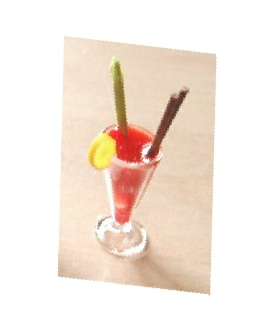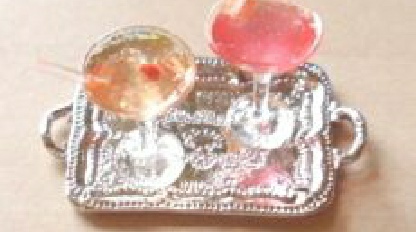Merry Gourmet Miniatures © 1988 - 2025 Designed By Bluechip Computer Support




|
Held between 5 o'clock and 7 o'clock it enabled a different and more social drinking, and especially for women. In general women did not drink during the day and if they did it was champagne with formal luncheons, but men had much more opportunities. Madeira and sherry at mid morning, wine at lunch, sherry again in the afternoon, at dinner parties all participants drank wine or champagne with the meal but the men then went on to circulate the port, while the women, having retired from the table, usually drank tea or coffee in the drawing room. Brandy and whisky for the men during bridge or a game of billiards rounded off the day. It was therefore daring and modern to have a party where strong drink was served, albeit mixed with (usually) quite sweet additions and the soft drink companies began to extend their ranges, while still catering for children another level emerged for the "grown ups". |

Carbonated water having been around since the end of the 18th Century, by the mid 19th Century had progressed to having various flavours added such as ginger, lemon, orange and herbs.
These had been further popularised by the inventions during the 1890s of the crown bottle cap and a glass blowing machine to mass produce glass bottles. With the advent of cocktails, sparkling soft drinks began to acquire a more sophisticated image on being used as mixers to dilute the strong liquors that were the basis of all the drinks.
Also used were Tonic (carbonated water flavoured with Quinine), Angostura Bitters,
(an infusion of gentian root and herbs on a strong rum base) various syrups and cordials
such as Grenadine (Pomegranate juice), Orgeat (Almond flavoured syrup) and Lime juice.
Liqueurs became popular as flavourings, mixed with the traditional spirits of gin, vodka, whisky, brandy and rum. They not only added sweetness, colour and flavour but potency as well.
Cherry Brandy, Blue Curcaco, Creme De Menthe, Peach Schnapps, Chartreuse, Mandarin Napoleon, Benedictine, Kirsch, Grand Marnier made colourful displays on the shelves behind the new cocktail bars in cocktail lounges being created in all the major hotels in London, Paris, Vienna, Nice, Monte Carlo.

This social event was an American invention which became very popular all round the world. When the London season was re-establishing itself at the beginning of the 1920's the rigidity of the pre-war season was much relaxed.
Younger sons having escaped the fate of their elder brothers and young ladies having
experienced more personal freedom and not now tolerating being chaperoned everywhere,
were not particularly captivated by a visit to view paintings or listen to Opera.
So the cocktail party was an amusing diversion between afternoon tea and shopping
and the evenings dances and parties.


In fact anywhere where the smart set congregated to dine and dance, for by now dances were no longer confined to private houses but had moved into hotels and night clubs had arrived to carry on the evenings jollity.
In America where many of the classic cocktails originated, Prohibition had led to a black market with boot leggers manufacturing liquor of sometimes very dubious quality. Bath tub gin needed a mixer to disguise the raw taste, the Orange Blossom Cocktail was the original gin and orange drink created to mask the ghastly flavour of the "moonshine".
The cocktails created during the Depression have named very evocative of their time and a lot are still popular today. Names for movie stars, famous people or the places they were first invented - Singapore Sling, Blue Hawaiian, Amsterdam, Moscow Mule, Manhattan, Bonnie Prince Charlie, Rob Roy, Tom Collins, Charlie Chaplin, Mary Pickford.
The bright young things downed them all before going on to charleston the night away, for along with the cocktails came JAZZ!